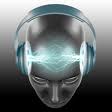Brainwave Entrainment
Brainwave Entrainment (BWE) is any practice that aims to cause brainwave frequency to synchronize with a periodic stimulus having a frequency corresponding to the desired brain-state; beta, alpha, theta, or delta. It`s based upon “frequency following response”, a naturally occurring phenomenon where the human brain has a tendency to change its dominant brainwave frequency towards the frequency of a dominant external stimulus. Such a stimulus may be sounds, as in binaural beats, monaural beats, and isochronic tones, or visual, using flashing lights, as with a dream-machine, or a combination of the two with a mind machine. BWE encourages “whole brain synchronization” which is coordination between the left and right hemispheres of the brain.
BWE audio recordings including binaural beats, monaural beat, & isochronic tones are used by many to provide benefits similar to those of traditional meditation. Some recordings are beats and tones only, some recordings embed these beats & tones into nature sounds, ambient music, singing, vocal guidance, or all four. It has been scientifically documented that periods of regular BWE can lead to an increase in overall emotional calmness, relaxation, deep inner peace, intelligence, creativity, focus, mental clarity, improved memory, heightened IQ, increased energy, and reduction in stress levels. These are the same benefits one experiences during traditional meditation, but can be achieved faster utilizing BWE.
Binaural beats are created by two tones pitched at slightly different frequencies with a difference between around 10 and 30 hertz. When the difference is placed at this level, what the mind “hears” is an overlay of the two sounds combined with a resonance which is the difference between the two frequencies. This difference is the frequency at which the brain responds. The brain then tends to follow the combined frequency difference automatically and falls into synchronicity with that frequency.
Monaural Beats are similar to binaural beats in the sense that they also use two tones to entrain brainwaves. Binaural beats use two tones of different frequencies that need to be listened to via stereo headphones. Monaural beats also use two tones, but they can be listened to via speakers (although headphones are recommended) because with monaural beats, the two tones mix before they reach the ear. Monaural beats are easier on the brain than binaural beats and have a stronger effect on the brain. It takes less time for the brain to adjust to monaural beats and thus you can get results fairly quickly.
Isochronic tones are comprise of a single tone which has an hypnotic effect upon the brainwave frequencies as they harmonize with the pulse. Isochronic tones are usually set at a specific frequency to have a specific effect upon the mind. The effect creates a relaxed alpha brainwave state which calms the constant chatter of the conscious. Isochronic are the most effective tones.
There are several types of brainwave states & your brain consistently cycles through each of these brainwave states many times throughout the day and night. It is a completely natural biological occurrence in every human being. Your brain does not operate in only one brainwave state at a time but instead pulses in all these brainwave states simultaneously, with one of the states being dominant at any given time. The dominant state indicates your “state of mind” or level of consciousness. Because different areas of the brain may have different activity at any given time, you may have activity in one brainwave state in one area of the brain while at the same time a different brainwave state may be more active in another area of the brain. Each of these brainwave states occurs in a specific frequency range.
Beta brainwaves are associated with a heightened state of alertness and focused concentration. When your mind is actively engaged in mental activities, the dominant brainwave state will be Beta. A person in active conversation, playing sports or making a presentation would be in a Beta state. The Beta brainwave state corresponds to frequencies ranging from 13Hz to 40Hz.
Alpha brainwaves state is slower in frequency than Beta brainwaves and represent a state of relaxed mental awareness or reflection. Alpha brainwave states are typically associated with contemplation, visualization, problem solving and accessing deeper levels of creativity. The Alpha brainwave state corresponds to frequencies ranging from 8 Hz to 12 Hz.
Theta brainwaves are even slower in frequency and represent a state of deep relaxation and meditation, enhanced creativity, stress relief, light sleep and dreaming. Theta brainwave states have been used in meditation for centuries. Research has proven thirty minutes a day of Theta meditation can dramatically improve a person’s overall health and well-being. Theta meditation has also been known to cause the need for less sleep. The Theta brainwave state corresponds to frequencies ranging from 4Hz to 8 Hz.
Delta brainwaves are the slowest in frequency and represent a state of deep dreamless sleep. Delta brainwave states have long been associated with healing. While Delta brainwave states usually only occur in deep sleep, it is possible to train yourself to remain awake while reaching the Delta state to experience even deeper levels of meditation and awareness. The Delta brainwave state corresponds to frequencies from 0Hz to 4H.

Also, see “Recommended Products” page for programs utilizing BWE.
Recommended Products ;









